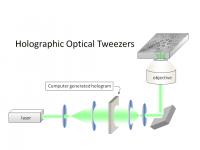Jul 7 2010
Star Trek fans will remember "tractor beams," lasers that allowed the Starship Enterprise to trap and move objects. Tel Aviv University is now turning this science fiction into science fact -- on a nano scale.
A new tool developed by Tel Aviv University, Holographic Optical Tweezers (HOTs) use holographic technology to manipulate up to 300 nanoparticles at a time, such as beads of glass or polymer, that are too small and delicate to be handled with traditional laboratory instruments. The technology, also known as "optical tweezers," could form the basis for tomorrow's ultra-fast, light-powered communication devices and quantum computers, says Dr. Yael Roichman of Tel Aviv University's School of Chemistry.
She's using these tweezers to build nano structures that control beams of light, aiding in the development of anything from optical microscopes to light-fuelled computer technology, she reports.
Holding onto the light
 The diagram shows TAU's holographic laser tweezers.
The diagram shows TAU's holographic laser tweezers.
HOTS are a new family of optical tools that use a strongly-focused light beam to trap, manipulate and transform small amounts of matter. First proposed as a scientific theory in 1986 and prototyped by a University of Chicago team in 1997, holographic optical tweezers have been lauded as indispensible for researching cutting-edge ideas in physics, chemistry, and biology.
Dr. Roichman and her team of researchers are currently pioneering the use of optical tweezers to create the next generation of photonic devices. Made out of carefully arranged particles of materials such as silicon oxide and titanium oxide, these devices have the ability to insulate light, allowing less energy to be lost in transmission.
"Our invention could increase transmission speed and save energy, important for long-life batteries in computers, for instance," says Dr. Roichman.
Photons are already used in optical fibers that bring us everyday luxuries like cable TV. But Dr. Roichman says this technology can be taken much further. In her lab at Tel Aviv University, she is advancing the previous study of photonic crystals, which control and harness light, by manipulating a variety of particles to create 3D heterogeneous structures. The ability to insulate light in a novel way, preserving its potential energy, is central to this goal.
No known material today can resist the flow of light -- its energy is either absorbed by, reflected off, or passed through materials. But Dr. Roichman has devised a new layering technique using special crystals central to the creation of photonic devices. These photonic crystals are arranged to create a path along which light can travel. If they're arranged correctly, she says, the light is trapped along the path.
In Dr. Roichman's approach, different materials are added to absorb or amplify light as required. She is hopeful that the ability to build these devices will transform communications, telescopic instruments, and even medical technology, making them more efficient and powerful.
Shining a light into a bacterium's belly
One project Dr. Roichman is working on tracks the effectiveness of antibiotics. Her improvements to optical microscopy will, for the first time, allow researchers to look at the internal processes within bacteria and see how different types of antibiotics attack them. More than that, her optical tweezers can isolate the bacteria to be studied, handling them without killing them.
Dr. Roichman, whose previous research was published in the journals Applied Optics and Physics Review Letters, notes that HOTs give researchers a platform with infinite possibilities. They give science a valuable tool to reach into the microscopic world -- and their building potential is endless.
Source: http://www.aftau.org/